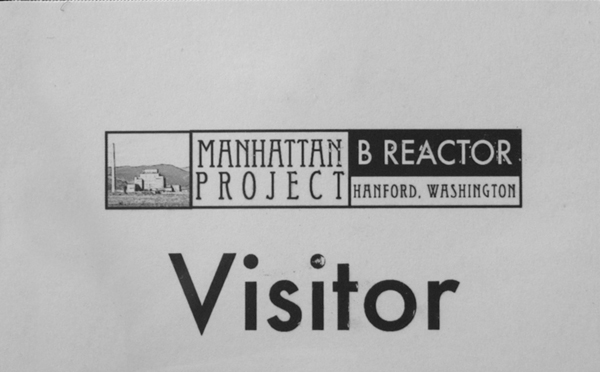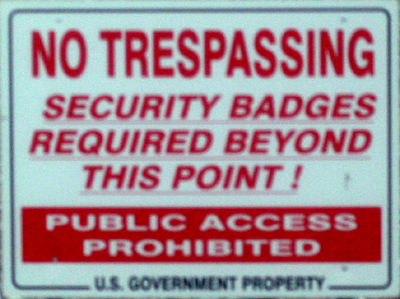 After having
wanted to do this for about three years, I finally landed a spot on a tour of
the Hanford
facility - actually, on both tours.
There are two tours offered of
Hanford. One takes in the
whole site, and lasts six or seven hours. You are taken within the
Hanford site, making
occasional stops at places like the B reactor, the waste disposal site, the
groundwater site, and various other clean up sites. The tour includes trips to the original town sites, the
area where the uranium rods were made, the reactor sites (mostly demolished and
encapsulated), as well as the locations of the plutonium extraction plants. Much
of this is gone now - sort of a nuclear ghost town, demolished or encapsulated. Various dump sites,
and landfills will also be visited, in various stages of decontamination.
No photography, note taking, or
any other kind of recording is permitted on this tour. Buses load at the Hammer
site, which is just up Horn Rapids Road, right by the Ariva factory, where
nuclear fuel is made for power reactors.
The second tour is shorter, and
only covers the B reactor; but in some ways is more satisfying. Photography is
allowed, and even encouraged. For this shorter tour, the bus ride circles around much
of the Hanford site, rather than passing through, and enters at a gate very near
the B reactor itself.
After having
wanted to do this for about three years, I finally landed a spot on a tour of
the Hanford
facility - actually, on both tours.
There are two tours offered of
Hanford. One takes in the
whole site, and lasts six or seven hours. You are taken within the
Hanford site, making
occasional stops at places like the B reactor, the waste disposal site, the
groundwater site, and various other clean up sites. The tour includes trips to the original town sites, the
area where the uranium rods were made, the reactor sites (mostly demolished and
encapsulated), as well as the locations of the plutonium extraction plants. Much
of this is gone now - sort of a nuclear ghost town, demolished or encapsulated. Various dump sites,
and landfills will also be visited, in various stages of decontamination.
No photography, note taking, or
any other kind of recording is permitted on this tour. Buses load at the Hammer
site, which is just up Horn Rapids Road, right by the Ariva factory, where
nuclear fuel is made for power reactors.
The second tour is shorter, and
only covers the B reactor; but in some ways is more satisfying. Photography is
allowed, and even encouraged. For this shorter tour, the bus ride circles around much
of the Hanford site, rather than passing through, and enters at a gate very near
the B reactor itself.
For those who are not familiar with the place,
Hanford
was the largest nuclear production facility in the country, perhaps the world, through most of the
Cold War. It produced huge quantities of plutonium, for use in nuclear weapons.
Two thirds of all of the plutonium produced in this country, was made right
here.
The Hanford site sits isolated and largely unacknowledged, as one of the
workhorses of the nuclear infrastructure, and one of the great battlefields of
The Cold War.
The desert and scrub of eastern
Washington
State is the last place you
might expect to find one of the premiere examples of leading edge nuclear
production facilities. On the other hand, considering the nature of the
Manhattan Project, and the nature of many of the sites and facilities which it
spawned, this might be exactly the kind of location you might expect. The
Hanford Site has much in common with the other Manhattan Project sites, such as
the Sandia Labs of Los Alamos, Trinity and White Sands, as well as the Arco site
in
Utah, and much of what
became the missile fields of the mountain states. Even Oak Ridge, has much in common
with the
Hanford site, despite the apparent differences in climate and topology.

At it’s peak, Hanford
had nine production reactors; but today is mostly concerned with clean up. With
the Cold War won, and large stockpiles of plutonium built up, places like
Hanford
are no longer needed - we hope. Should the need ever arise to increase our
nuclear stockpile; we have something like 100 tons of plutonium in secure
facilities. It takes around thirteen pounds to make the core of a nuclear
weapon, so we are not likely to fall short.
Unfortunately,
production of two thirds of the nation's plutonium means accumulation of two
thirds of the nation's production related nuclear waste. The Hanford
site is the most radioactively contaminated place in the nation – more so than
the Nevada Test Site, The Trinity Site, or any other nuclear site. There is more
radioactive contamination here, measured in tons (that's right - tons), than at Hiroshima,
or Nagasaki, where the bombs were
dropped. Various clean up, containment, and decontamination processes are being
developed here, by necessity. Upon completion of these cutting edge procedures,
the people here will be the world experts at vitrification and site remediation.
There is also still some nuclear research being conducted here, and the site is
the home to the Pacific Northwest National Laboratory.
 This is
a different kind of tour, for quite a different
kind of tourist; but it is a unique, historic, and fascinating place. It is
also, for those of us who lived through the Cold War, as much a battlefield as
Gettysburg, or Appomattox.
Places like this were where the Cold War was ultimately fought and won – without
a shot being fired. If you have a desire to see this place, now is the time.
Tour slots are limited and must be reserved ahead of time. Spots fill fast –
sometimes by the morning of the first day that they open. This is no
exaggeration – if you are interested, click on one of both of the links below, right now!
If there are no slots available, check back - people cancel all the time. If you
are lucky, you may get a spot on both tours. The links at the top and bottom of
this page lead to accounts of my own visits, with photographs where allowed.
This is
a different kind of tour, for quite a different
kind of tourist; but it is a unique, historic, and fascinating place. It is
also, for those of us who lived through the Cold War, as much a battlefield as
Gettysburg, or Appomattox.
Places like this were where the Cold War was ultimately fought and won – without
a shot being fired. If you have a desire to see this place, now is the time.
Tour slots are limited and must be reserved ahead of time. Spots fill fast –
sometimes by the morning of the first day that they open. This is no
exaggeration – if you are interested, click on one of both of the links below, right now!
If there are no slots available, check back - people cancel all the time. If you
are lucky, you may get a spot on both tours. The links at the top and bottom of
this page lead to accounts of my own visits, with photographs where allowed.
Reserve your spot now!
For tours of the entire site (no photography permitted):
http://www5.hanford.gov/publictours/
For tours of the B reactor only, where photography is allowed:
http://manhattanprojectbreactor.hanford.gov/?tour=registrationstar
After having
wanted to do this for about three years, I finally landed a spot on a tour of
the
This is
a different kind of tour, for quite a different
kind of tourist; but it is a unique, historic, and fascinating place. It is
also, for those of us who lived through the Cold War, as much a battlefield as